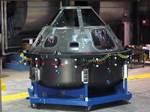Building on CCM lessons learned
Knowledge gained during NASA's composite crew module (CCM) program, a sidelight to the Orion space capsule program, now benefits private space efforts.
In space, every pound of weight affects mission capacity and overall project cost, which makes the use of composites very attractive. That’s why the NASA Engineering and Safety Center (NESC, Hampton, Va.) designed, built and tested a composite crew module (CCM) in parallel with the Constellation program’s Orion crew module development. Some of the lessons learned were applied to Orion and are now benefiting other programs within NASA and beyond.
“Members of the composite crew module team have had technical discussions with Blue Origin and Sierra Nevada regarding how we used composites, including our design, analysis, manufacturing and test processes,” says Mike Kirsch, NESC principal engineer and CCM project manager. “We have been asked to participate in design reviews of their systems,” he adds, confirming that both companies are using composites in their primary structures.
The NESC worked with a number of NASA and industry partners on the CCM project (see “Simulation simplifies fabrication ...." under Editor's Picks," at right ).
Fabricated at Alliant Techsystems (ATK, Iuka, Miss.), the CCM incorporated an innovative approach to joining composites developed by Northrop Grumman Aerospace Systems (Redondo Beach, Calif.) and carbon fiber tooling firm Janicki Industries (Sedro-Woolley, Wash.). The top and bottom halves of the CCM were hand layed sandwich structures with an aluminum honeycomb core and carbon fiber-reinforced facesheets. During layup, critical orthogonal joints were assembled, using preformed three-dimensional weaving technology. After they were autoclave-cured, the two halves were spliced together, using local heaters and vacuum bags, reports the NESC. According to the NESC, the use of complex composite shapes allowed the integration of the packaging backbone (used to secure internal components) with a membrane-lobed floor and pressure-shell walls, which reduced mass by approximately 150 lb/68 kg.
“As loads and environments change with program maturation, inner mold line tooling offers the opportunity to optimize or change design through tailoring of layups or core density,” reports the NESC. “Composite solutions offer opportunity for lower piece-part numbers, resulting in a lower drawing count, which helps minimize overall lifecycle costs. Also, a minimal number of tools are required to manufacture the primary structure.”
The module was pressurized to twice Earth’s atmosphere to “demonstrate the ultimate design capability of the structure,” explains Kirsch. This was followed by push-pull tests to simulate the on-mission forces. In all, the CCM showed that it could complete its mission, even with the kind of damage that is likely to occur in space.
Related Content
-
Cryo-compressed hydrogen, the best solution for storage and refueling stations?
Cryomotive’s CRYOGAS solution claims the highest storage density, lowest refueling cost and widest operating range without H2 losses while using one-fifth the carbon fiber required in compressed gas tanks.
-
PEEK vs. PEKK vs. PAEK and continuous compression molding
Suppliers of thermoplastics and carbon fiber chime in regarding PEEK vs. PEKK, and now PAEK, as well as in-situ consolidation — the supply chain for thermoplastic tape composites continues to evolve.
-
Plant tour: Joby Aviation, Marina, Calif., U.S.
As the advanced air mobility market begins to take shape, market leader Joby Aviation works to industrialize composites manufacturing for its first-generation, composites-intensive, all-electric air taxi.















